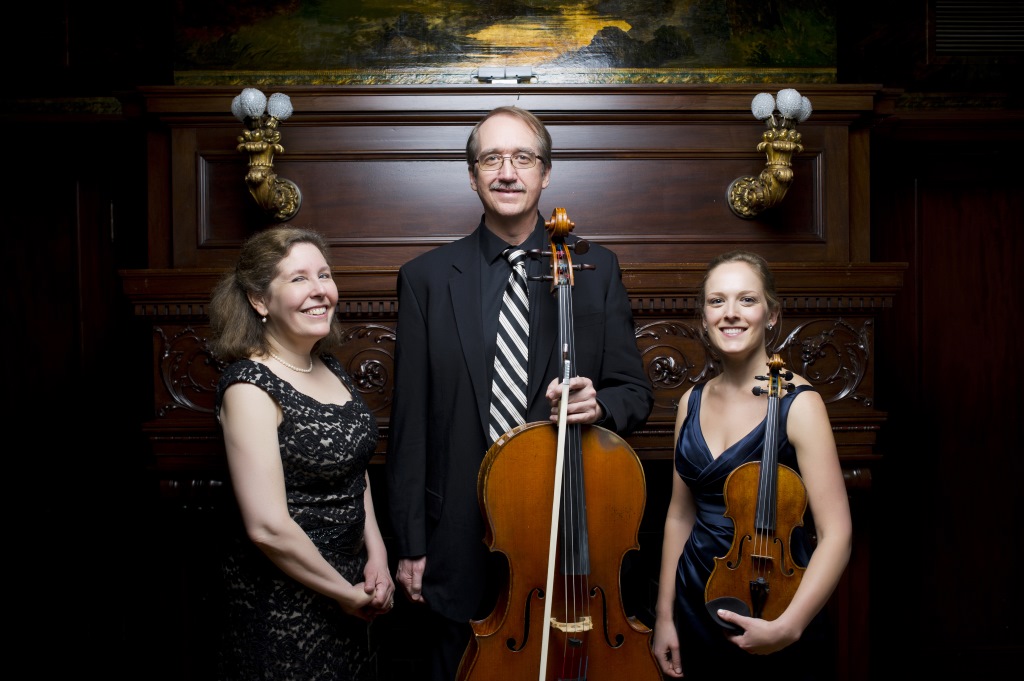A Celtic Folk Song Transformed
Prometheus Trio performs a contemporary trio by Hagen, plus works of Dvorak, Faure.
The Prometheus Trio program for their February concert will feature reflective works by composers that imagine musically what was, what is, and what could be. Antonin Dvořák, 34 years old when he composed the Trio in B-flat Major, was at the cusp of his international recognition. Daron Hagen, whose Piano Trio No. 5 will be premiered during the concert, is a highly successful contemporary composer with an extensive catalogue of opera, symphony and chamber music. Gabriel Fauré composed the Trio, Op. 120 in his final years. Despite Dvořák and Hagen’s youth at the time of writing their trios, a strain of melancholy runs through their pieces, as it does through the Fauré trio.
The Prometheus Trio is pianist Stefanie Jacob, cellist Scott Tisdel, and violinist Margot Schwartz. They performed Hagen’s Piano Trio No. 3, “Wayfaring Stranger” in an April 2015 concert.
Monday night’s premiere of Piano Trio No. 5, “Red is the Rose” (2017) by Hagen is the centerpiece of the concert. The subtitle of the trio “Red is the Rose” refers to an Irish folk song, recognizable through another name as the Scottish tune “Loch Lomond.” Hagen’s trio is divided into four movements that have intimate, confessional titles. Movements two and four consist of variations on “Red is the Rose.” Movement two is dedicated to the legendary Irish singer Tommy Makem, whose 1990 recording of the tune brought it to Hagen’s attention. Hagen’s commentary on the inspiration for the trio is available online.
Hagen’s use of the theme and variation format for the trio is something of a musical reflection on traditions of folk music. Scottish and Irish traditional music are part of a fluid Celtic tradition that includes the Isle of Man, Cape Breton and Appalachian folk music. Trying to date or fix a name on any one tune is difficult, as songs were passed on by oral tradition, so it’s no wonder that there are different names for the same tune. Lyrics were frequently changed to suit the singer and the occasion–and changed again as people learned by ear. This appears to have happened with “Red is the Rose,” which was recorded under the completely different title “My Bonnie Irish Lass” by Josephine Beirne and George Sweatman in 1934. Makem learned the tune from his mother, who was from Armagh, Northern Ireland (about 150 miles to Glasgow, Scotland as the crow flies). In Irish tradition, there’s almost always a political subtext to the lyrics. “Loch Lomond” itself is about the Battle of Culloden in 1746. Despite an apparent love story, some say that “Red is the Rose” represents the experience of emigrating to America.
Josephine Beirne and George Sweatman, “My Bonnie Irish Lass” (“Red is the Rose”), 1934.
The Monday evening program opens with the Trio, Op. 120 (1922-23) by Gabriel Fauré. Fauré and Dvořák were almost exact contemporaries and led similar lives, each rising from humble beginnings. Fauré’s long life spanned Romanticism and Modernism. He was one of the central composers of the French belle epoque, along with Bizet, Saint-Saens, Debussy, and his music bears the unmistakable refinement of the French fin de siecle.
Around the time that he began composing the Trio, he wrote to his wife, “The trouble is that I can’t work for long at a time. My worst tribulation is a perpetual fatigue.” He worried, “Have I come to the end of my resources?” It was just after the war that devastated Western Europe; he had resigned as director of the Paris Conservatoire on October 1, 1920; he was 77, almost deaf, and recovering from pneumonia. He went to the resort town of Annecy-le-Vieux near Geneva in August 1922 to begin writing, and initially scored the work for clarinet, cello, and piano before deciding finally to change the clarinet part to the violin. It would be his only piano trio and one of two final works.
The first performance was at the Société Nationale de Musique, in a concert celebrating his 78th birthday on May 12, 1923. Although he was too ill to attend the premiere, he later attended a performance by violinist Jacques Thibaud, cellist Pablo Casals, and pianist Alfred Cortot.
Closing the program is Antonin Dvořák’s Trio in B-flat Major, Op. 21 (1875). Dvořák wrote the trio in 1875, during an incredibly productive year that included seven compositions including an opera, a symphony, and several chamber works. The trio dates from what has been called his “First Slavonic period,” in which he was moving from an experimental phase to classicism and more traditional harmony. Dvořàk’s music is notable, of course, for its Czech folk elements and critics point to his frequent use of the dumka, a lamentation, in his work. It appears in the second movement of the trio. Because he was an assiduous reviser of his scores, Dvořák’s trio did not receive a public performance until February 1877.
Concerts are on Monday, February 12 at 7:30 p.m. and Tuesday, February 13 at 11:00 a.m. The Prometheus Trio performs at the Wisconsin Conservatory of Music, 1584 N. Prospect Avenue. Tickets may purchased online or at 414-276-5760. Milwaukee Eye Care provides free parking at 1684 N. Prospect Ave.
Preview
-
A Sacred Choir, 70 Voices Strong
 Dec 14th, 2025 by Martha Brown
Dec 14th, 2025 by Martha Brown
-
Prometheus Trio Goes Bohemian
 Dec 3rd, 2025 by Martha Brown
Dec 3rd, 2025 by Martha Brown
-
Present Music Offers New Choral Works
 Nov 20th, 2025 by Michael Barndt
Nov 20th, 2025 by Michael Barndt



















